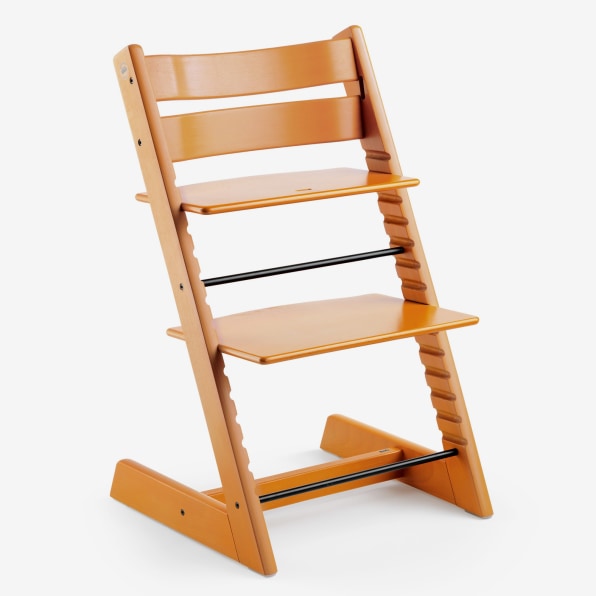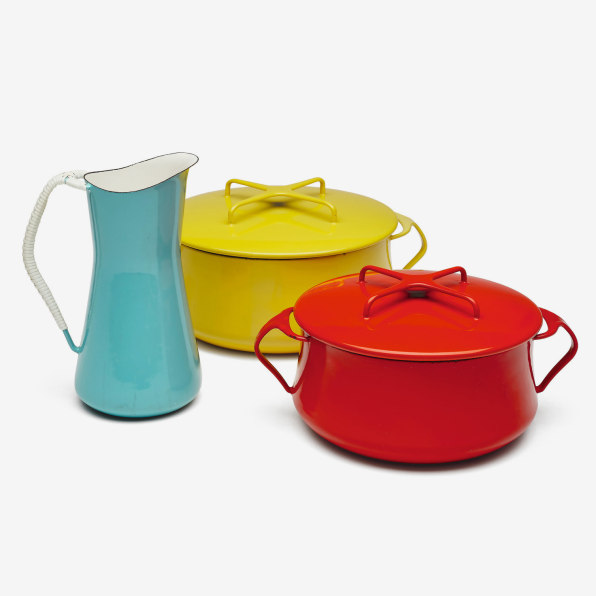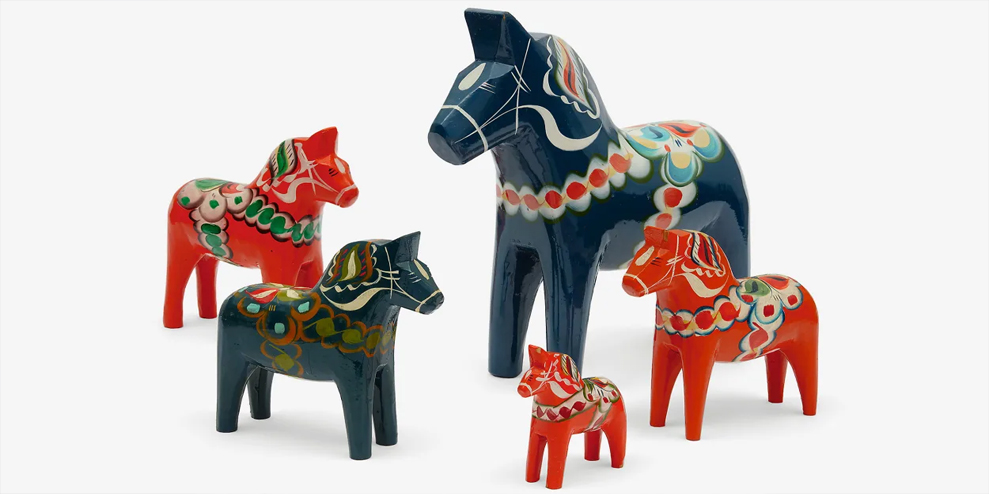The Nordic countries’ indelible influence on design is part style, part myth, part marketing.
It’s almost taken for granted in the United States that Scandinavian design is just better. Simple, functional, and minimalist, Scandinavian furniture, housewares, decorations, and even toys have become prized pieces in many American homes, as well as signifiers of worldly good taste. This did not all happen by accident, nor by the elevated design sensibilities of the American aesthete. This happened because clever marketers in both Scandinavia and the U.S. saw a boundless business opportunity.
A new exhibition at the Los Angeles County Museum of Art (LACMA) delves into the history behind Scandinavian design’s ascendance in the U.S. and finds that, while some of the products are clearly excellent, much of the spread of the Scandinavian design aesthetic is more the result of clever marketing.
“There’s this very long, multigenerational, and sustained influence of Scandinavian design, both from immigrants and from marketing and advertisements,” says Bobbye Tigerman, a curator of decorative arts and design at LACMA, who co-curated the exhibition Scandinavian Design and the United States, 1890–1980, running now through February 5, 2023. It’s a phenomenon “that begins in the late 19th century with the arrival of many Scandinavian immigrants and continues arguably until today.”

The exhibition looks at the cultural exchanges between the U.S. and the Nordic countries of Denmark, Finland, Iceland, Norway, and Sweden. Though some of this exchange was from the U.S. side to the Nordics, much of it was an importation–and sometimes bald-face appropriation–of the Scandinavian style and mystique.
Tigerman explains that following the Second World War, the Nordic nations were poor and very eager to sell their goods to a flush American market. Previously thriving Nordic industries, like rifle manufacturers, saw their business exporting to the U.S. dry up in wartime, and postwar consumerism was much more oriented toward household goods. Tigerman says savvy business people in Scandinavia saw an opportunity to reframe what they could sell to the U.S. by capitalizing on many of the stereotypes Americans had about Scandinavians and the goods they produced. “The stereotypes about Scandinavian design being organic, modern, comfortable, gentle, were just that–they were myths that were created,” she says.
But the Scandinavian design aesthetic wasn’t all a marketing trick pulled on the spend-happy American consumer. Scandinavian designers and companies (and Scandinavian designers working for American companies) also produced many high-quality goods, from modern wood furniture and cabinets to elegant glassware to common children’s goods like the Baby Bjorn baby bouncer and the height adjustable Tripp Trapp highchair from the Norwegian company Stokke.
Tigerman co-curated the exhibition with Monica Obniski, formerly of the Milwaukee Art Museum, which provided many of the 175 items in the show, along with the Nationalmuseum Sweden in Stockholm and the Nasjonalmuseet in Oslo, Norway. The exhibition puts these items in the context of migration and U.S. race relations, Cold War tensions in the Nordic region, the growth of design for social change, and the sheer power of an international marketing machine.

The idea for the exhibition connects back to a single object, the first that Tigerman acquired for LACMA after joining the museum in 2007. It’s a desk from 1952 produced by an American company and designed by Greta Grossman, a Swedish carpenter and cabinetmaker who fled to the U.S. with her Jewish husband in 1940. The desk, a minimalist and modern form, has a blocky storage area on one side, a simple flat surface and backdrop, and crossed stick legs on the other side combining iron and walnut. Topped with micarta, a plastic-like predecessor to Formica, the desk appears hand crafted but was designed for industrial production. “To me it absolutely embodies an integration of both Scandinavian and California ideas,” Tigerman says.
The combination of industrial production and Scandinavian design aesthetics would spread across the American consumer goods market in the 1950s. Though Scandinavian design became a highly marketable term in the booming postwar years in the U.S, the influence of Scandinavian designers stretches back into the late 1800s. Tigerman says Scandinavian immigrants helped bring over some of the region’s design traditions, and shaped generations of designers in the U.S.

While the German Bauhaus school gets a lot of credit for the way its instructors influenced architecture and industrial design across Europe and the U.S., Scandinavians were perhaps equally influential. They were among the early instructors of Cranbrook, the art and design school founded in 1904 outside Detroit that educated major American designers, including polymath designers Charles and Ray Eames, furniture designers Florence Knoll and Harry Bertoia, and ceramicist Toshiko Takaezu.
The early influence of Scandinavians was also a product of the times. “Scandinavian immigrants were white and protestant, so it was easier for them to integrate into established society than people that were coming from other racial or religious groups,” Tigerman says. “They didn’t have as many barriers to contend with.”
The exhibition doesn’t ignore the ways that American business and consumerism has taken the Scandinavian look or concept and made it a mass market commodity. One unexpected example is the Troll doll, the small plastic toy doll with wild fuzzy hair. Invented by a Danish designer to play up a major element of Nordic folklore, the Troll doll became a mass market hit in the U.S. beginning in the early 1960s. “I think the Troll doll would not fall into what people would usually associate with Scandinavian design,” Tigerman says. But, she argues, it is a perfect blend of Scandinavian design and self-aware stereotypes, and the mass production and consumer culture in the U.S.
There’s also Dansk Designs, the company that manufactured enameled steel cookware that became common in American kitchens in the 1950s and ’60s. Actually an American company, Dansk Designs simply hired Danish designers and turned their work into accessible and affordable housewares.
And then there’s Lego, the poster child for elegant Scandinavian design that eschewed the American mode of designing cheap and silly toys. The exhibition includes the first Lego set sold in the U.S., released in 1961 and mass produced in the U.S. by Samsonite under a licensing agreement. “Lego was presented as a toy that doesn’t go ‘bang bang.’ It’s a learning toy and it sparks creativity,” Tigerman says. “Ideas about what constituted creative play, Scandinavians were leaders of that, and that is only more a part of our consciousness today about what kinds of toys are healthy and quote-unquote good toys.”
The exhibition’s time frame ends in 1980, but the Scandinavian-American design story does not stop there. One big example Tigerman points out: The 1985 opening of the first U.S. Ikea store. The spread of Scandinavian design into American homes since then is almost impossible to avoid. And that even extends to culture, Tigerman says, with Nordic noir novels being translated into English and TV shows ending up on Netflix, and the Danish concept of hygge inspiring an obsession with coziness. Whether it’s just good design, good marketing, or a mix of the two, Scandinavian design is here to stay, says Tigerman. “What we’re saying is Scandinavian design and Scandinavian culture is so pervasive that it almost has become American.”
—
This article first appeared www.fastcompany.com
Seeking to build and grow your brand using the force of consumer insight, strategic foresight, creative disruption and technology prowess? Talk to us at +971 50 6254340 or engage@groupisd.com or visit www.groupisd.com/story

